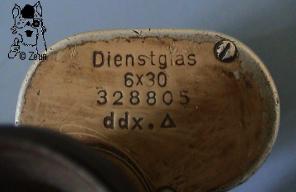


Re: Zeiss unusual 7x30 dienstglas similar (no serial number) to Silvamar « Reply #26 on: July 12, 2018, 10:49:16 PM » I know some French companies made sizes 'in between' such as 7-1/2x.

The first number (6) refers to the magnification and the second number (30) indicates the diameter of the objective lens (the light-gathering lens) in millimeters. 6×30 designates the capacity of the binoculars. The most common type is the 6×30 strength Dienstglas. These where therefor engraved with Dienstglas noting the army property.
#DIENSTGLAS 6X30 DDX SERIAL NUMBERS SERIAL NUMBERS#
Rain cover: Bakelite with stitched leather attachment.Dienstglas 6x30 Ddx Serial Numbers Rating: 3,0/5 7075 votes Strap: unadjustable strap with anodized aluminium studs Maker: ddx refers to the maker Voigtlaender u. This case has a loop on the back to be carried on the equipment belt and a strap to be slung over the shoulder. It is fastened with one or two metal studs.ġ Behalter, a leather, bakelite or Presstoff case to protect the binoculars in transit. It is attached to the straps and often referred to as a rain shield.ġ Knopflasche, a leather or presstoff piece of material meant to strap the binoculars to a button on the tunic. Sometimes these straps are adjustable with multiple stud holes but most of the time they are not.ġ Okularschutz, a leather, bakelite or rubber eye shield cover to keep dirt out of the lenses. The binoculars are featured with 4 accessories:ġ Trageriemen, a narrow leather string attached with two metal studs. I will further discuss the use of this in another article that will be linked here. The right eyepiece features a reticle or Strichplatte in scale 6400 which is used to calculate distances. The binoculars have two adjustable eyepieces or Okulare with bakelite or aluminium end pieces. Later in the war binoculars where also finished in tan or Sandgelb paint. The metal ones where first furnished with a leather or pressed paper wrap and later in the war in different finishes such as Anodization, Paint or Bluing. These binoculars where made out of different materials such as Aluminium, Zinc and Bakelite. The first number (6) refers to the magnification and the second number (30) indicates the diameter of the objective lens (the light-gathering lens) in millimeters. The most common type is the 6×30 strength Dienstglas. 6×30 designates the capacity of the binoculars. These where therefor engraved with Dienstglas noting the army property. These binoculars or Doppelfernrohr where expensive and strictly army property. Home / Militaria Reference / Field equipment / 6×30 Dienstglas – ddx 6×30 Dienstglas – ddxĭuring the war the German army issued binoculars to some of their troops with specialised functions. The Gruppenführer or group leader would have one for instance.


 0 kommentar(er)
0 kommentar(er)
